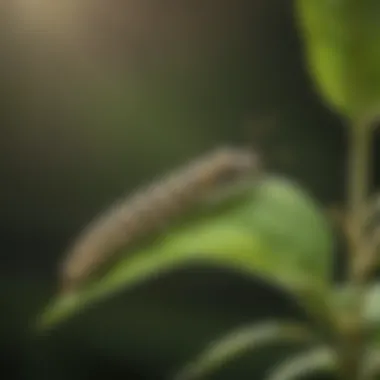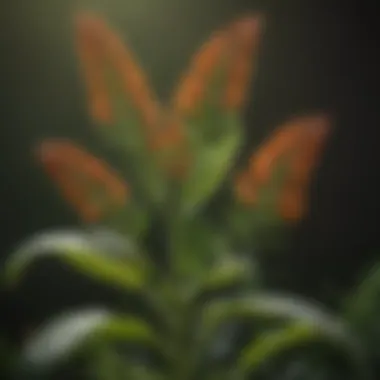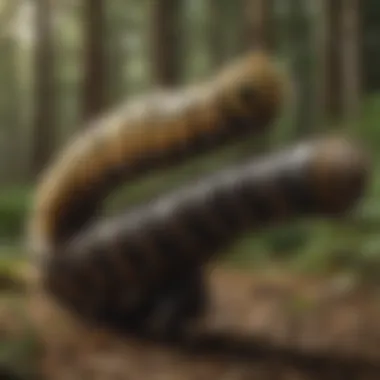Dietary Preferences of Monarch Caterpillars: Host Plant Insights


Intro
Monarch caterpillars, known for their striking appearance, exhibit specific dietary preferences that are crucial for their growth and survival. Their reliance on milkweed species forms the backbone of their nutritional requirements. Understanding this relationship is essential not only for effective rearing practices but also for conservation efforts aimed at supporting both the caterpillars and their habitats.
Dietary Requirements of Monarch Caterpillars
Monarch caterpillars primarily feed on milkweed plants. This plant is not just a food source; it is vital for their development. Monarchs have evolved to consume toxic compounds known as cardenolides found in milkweed. While these compounds can be harmful to other creatures, they provide monarchs with a form of defense against predators.
Nutritional Components
The nutritional profile of milkweed includes essential components such as:
- Proteins: Critical for growth and transformation.
- Fats: Important for energy and overall health.
- Carbohydrates: Serve as a primary energy source.
These components facilitate the various stages of caterpillar growth, from larval to pupal stages. The rich supply of these nutrients in milkweed enables monarchs to thrive in their natural habitats.
Importance of Milkweed
Milkweed Species
Not all milkweed species are equal. Some species provide better nutrition than others, which can impact caterpillar growth rates and survival. The main types of milkweed include:
- Common milkweed (Asclepias Syriaca): Widely found in North America, it is highly nutritious.
- Swamp milkweed (Asclepias incarnata): Preferred in wetland areas, this species offers good nutritional value.
- Butterfly weed (Asclepias tuberosa): While attractive, it is less favored by monarch caterpillars for feeding.
Ecological Role
Milkweed serves as a keystone in the ecosystem by supporting not only the monarch caterpillars but also various pollinators. By fostering the growth of milkweed, we protect the intricate web of life that sustains these beautiful butterflies.
"The diet of the monarch caterpillar is as much about survival as it is about growth. Selecting the right plants is key to successful rearing."
Rearing Considerations
For individuals interested in rearing monarch caterpillars, choosing the appropriate milkweed species is critical. In natural and controlled environments, the correct selection can lead to improved outcomes. Farmers and hobbyists alike must prioritize conservation practices to ensure that milkweed populations thrive.
Preamble to Monarch Caterpillars
Monarch caterpillars primarily feed on milkweed, a plant that is crucial not only for their survival but also for the overall ecosystem. This article will explore the nutritional needs of these caterpillars, the specific types of milkweed they prefer, and the ecological ramifications of their feeding choices. A comprehensive understanding of these aspects is vital for conservation efforts and for those interested in successfully rearing monarchs in controlled environments.
Lifecycle Overview
The lifecycle of monarch caterpillars is one of nature's most fascinating processes. It begins with the female monarch laying eggs on the undersides of milkweed leaves. After a few days, the larvae hatch, emerging with an instinctive ability to consume the very leaves they were born on. This critical phase is characterized by rapid growth, as the caterpillars molt several times, increasing in size and preparing for metamorphosis.
Each stage of their development is intimately tied to their dietary intake. Sufficient access to milkweed is necessary for the caterpillars to accumulate the energy and nutrients needed for their transformation into adult butterflies. Without an adequate food supply, developmental delays or mortality can occur.
Significance in Ecosystems
Monarch caterpillars hold significant ecological roles, primarily through their interaction with milkweed plants. By feeding on milkweed, these caterpillars contribute to the ecological balance by ensuring that the plants' populations are maintained. Additionally, their voracious eating habits can influence the dynamics of plant communities.
Their relationship with milkweed extends beyond mere consumption. The caterpillars accumulate toxic compounds from the plant, which in turn provides them with a defense mechanism against predators. This bioaccumulation not only aids their survival but also reflects the intricate connections present within ecosystems.
Furthermore, as monarchs transition into butterflies, they become pollinators, further contributing to biodiversity. This dual role emphasizes why understanding their dietary preferences is crucial not just for their survival, but for the health of the ecosystems they inhabit.
Monarch caterpillars and their dietary choices profoundly affect not only their survival but the broader ecological networks they are part of.
Nutritional Needs
Understanding the nutritional needs of monarch caterpillars is crucial for their survival and development. These needs are not just about sustenance; they directly impact their growth, metamorphosis, and ultimately, their chances of flourishing in various habitats. The dietary requirements of these caterpillars center around their host plants, primarily milkweeds, which provide essential components necessary for their growth.


A balanced diet influences critical physiological processes such as transformation into butterflies. Therefore, knowing the intricate relationship between monarch caterpillars and their dietary preferences can offer insights into their role in the ecosystem and the importance of conserving their natural habitats.
Essential Nutrients for Growth
Monarch caterpillars have specific nutrient requirements that must be met to ensure they reach maturity. These include:
- Proteins: Vital for tissue growth and repair, playing a significant role in muscular and organ development.
- Lipids: Provide a concentrated source of energy, essential for a caterpillar's active growth phases.
- Carbohydrates: Mostly derived from the breakdown of plant material, carbohydrates serve as a quick energy source.
- Vitamins and Minerals: These elements are crucial for various metabolic activities, including enzyme functions and overall health.
The primary source of these nutrients is the leaves and stems of specific host plants. For monarchs, milkweed stands out as the best source due to its unique chemical composition that aligns with the caterpillars' needs. Without access to these vital ingredients, the caterpillars may not thrive and could face potential developmental setbacks.
Role of Proteins and Lipids
Proteins and lipids hold a pivotal role in the life of monarch caterpillars. Proteins contribute to growth rates and the ability to develop properly functioning tissues. A caterpillar that lacks adequate protein in its diet will display slower growth rates, which could hinder its progression through the instar stages.
Lipids serve as an energy source, particularly during the later stages of instar development, when energy demands increase. The storage of lipids can also be vital during the pupation phase when the caterpillar transforms into a chrysalis. Without sufficient lipid reserves, it may struggle to undergo metamorphosis successfully.
"A well-balanced diet is not merely an option; it forms the very foundation of a monarch caterpillar's existence, guiding its journey from caterpillar to butterfly."
Preferred Host Plants
Understanding the preferred host plants of monarch caterpillars is essential for their survival and development. Monarch caterpillars are highly specialized feeders, primarily relying on milkweed species. This section sheds light on why these plants are crucial to the caterpillars' diet, highlighting their benefits and considerations for conservation and sustainable practices.
Milkweed Species
Milkweed plants are the cornerstone of the monarch caterpillar's diet. The species within this category provide not only the necessary nutrition for growth but also the chemical compounds that make the caterpillars unpalatable to predators. Some key milkweed species include:
- Common Milkweed (Asclepias Syriaca): This is one of the most iconic species, known for its vibrant flowers and easy accessibility. It offers a rich source of nutrients that supports robust caterpillar development.
- Butterfly Weed (Asclepias Tuberosus): With its bright orange flowers, this species attracts not only monarchs but also various pollinators. It has a high density of latex, which can deter some predators.
- Swamp Milkweed (Asclepias Incarnata): Thriving in moist conditions, this variety is essential for habitats that experience wet soil. Its neoprene-like foliage is often favored by caterpillars seeking fresh leaves.
The presence of these milkweed species in the environment is critical for sustaining monarch populations. Furthermore, they contribute to ecological balance by supporting various insects and facilitating plant-animal interactions.
Other Suitable Plants
While milkweed is vital for the survival of monarch caterpillars, other suitable plants can occasionally supplement their diet. These plants may not be the primary food source but can still provide nourishment in certain conditions. Some notable alternatives include:
- Violets: These flowers serve as a food source during lean times, though they are not a preferred choice.
- Dandelion: This common weed can provide supplementary nutrition in urban areas where milkweed may be scarce.
- Hibiscus: In tropical regions, hibiscus leaves can be a fallback food source when milkweed is not easily available.
It is essential to recognize that while these alternatives can be beneficial, they should not replace the need for milkweed. Conservation efforts focused on protecting and restoring milkweed habitats are critical to the survival of monarch caterpillars.
Milkweed Varieties
Common Milkweed
Common Milkweed, or Asclepias Syriaca, is one of the most recognizable milkweed species. This variety offers benefits such as:
- High Nutritional Value: Rich in essential nutrients that caterpillars need.
- Preferred Host Plant: Most monarch caterpillars select this plant for feeding.
- Adaptability: Grows in a variety of conditions, making it widely accessible.
The presence of Common Milkweed promotes healthy caterpillar development. Additionally, it provides habitats for various pollinators. Its flowers are favored by butterflies and bees, thus supporting biodiversity.
Butterfly Weed
Butterfly Weed, also known as Asclepias tuberosa, is another noteworthy milkweed species. It features bright orange flowers that are visually appealing. Here are some relevant points about Butterfly Weed:
- Drought-Resistant: This plant thrives in dry soils, which can be advantageous in certain climates.
- Attractive to Pollinators: It provides a food source not only for monarch caterpillars but also for adult butterflies.
- Lower Toxicity: Compared to other milkweeds, it has a different chemical profile, which may make it less toxic to certain insect populations.


Butterfly Weed's role in the ecosystem is crucial, serving both caterpillars and adult butterflies. Its resilience ensures its growth even in less-than-ideal conditions, which makes it a valuable addition to conservation efforts.
Swamp Milkweed
Swamp Milkweed, or Asclepias incarnata, is less commonly known but equally important.
- Moisture-Loving: This species thrives in wet soils, ideal for swampy or low-lying areas.
- Rich in Nutrients: It provides essential elements that caterpillars require for growth.
- Resilience Against Pests: The robust nature of Swamp Milkweed helps it compete against various pests.
Incorporating Swamp Milkweed into habitats can attract monarch caterpillars while also providing a stable food source in challenging environments. Each of these milkweed varieties plays a crucial role in supporting the lifecycle of monarch caterpillars.
"A healthy population of monarch caterpillars signals a thriving ecosystem, emphasizing the importance of diverse milkweed species in our environment."
By promoting the growth of these milkweed types, we ensure not just the survival of monarch caterpillars but also a balanced ecosystem that supports multiple species. Encouraging varied milkweed planting can lead to better conservation practices. In summary, Common Milkweed, Butterfly Weed, and Swamp Milkweed each provide substantial benefits vital for monarch caterpillar development.
Seasonal Variations in Diet
Seasonal changes significantly impact the dietary habits of monarch caterpillars. Understanding these variations not only provides insight into their survival strategies but also emphasizes the need for conservation initiatives aimed at preserving their preferred habitats. Throughout different seasons, the availability and nutritional quality of host plants, particularly milkweed species, fluctuate. Caterpillars must adapt to these changes to ensure their growth and development remain optimal.
Spring and Summer Diet
During spring and summer, monarch caterpillars have access to a plethora of milkweed species, which are crucial for their nutrition. As these caterpillars emerge in early spring, they often find new growth on milkweed plants, which is rich in vital nutrients. This period is marked by an increased availability of leaves, providing abundant feeding opportunities. The young caterpillars primarily consume young, tender leaves, which have the highest nutrient content.
These months represent peak reproductive times for both monarchs and their host plants. The leaves are high in water and proteins, supporting rapid growth rates in the caterpillars. Key nutrients from milkweed that support caterpillar development in these warmer months include:
- Proteins: Essential for muscle development and overall health.
- Lipids: Provide energy necessary for metabolic processes.
- Vitamins: Crucial for immune function and growth.
The relationship between the caterpillars and their host plants during this period is symbiotic. The caterpillars eat the milkweed, while the plants benefit from the removal of older leaves, allowing for new growth. This cycle promotes a flourishing ecosystem that supports the caterpillars' rapid life cycle in warm weather.
Autumn Adaptations
As summer transitions to autumn, the landscape changes significantly, which influences the dietary habits of monarch caterpillars. By this time, many milkweed plants begin to lose their vitality. Leaves may become tougher, and nutritional content often declines. This calls for adaptations in feeding strategies among the caterpillars.
In autumn, monarch caterpillars may refine their diets to include different segments of the milkweed plant. They may consume older or tougher leaves as younger leaves become scarce. The caterpillars might also start to feed more on the flowers and seed pods, which can offer alternative nutrient sources.
"Understanding the seasonal variations in diet helps in preparing appropriate conservation strategies for monarchs."
It is crucial for conservationists and researchers to recognize these shifts, as they reflect the caterpillars' resilience and adaptability. Ensuring that there is continued access to diverse milkweed species throughout the seasons can significantly enhance survival rates and support the life cycle of these insects.
Interactions with Other Species
Understanding the interactions between monarch caterpillars and other species is crucial in the broader context of their dietary preferences and ecological relevance. These interactions shape not only their growth patterns but also their resilience and survival. The caterpillar's dependence on specific host plants, such as various milkweed species, is both a strength and a vulnerability. It highlights the complex relationships that dictate their role in the ecosystem.
Predators and Parasites
Monarch caterpillars face a number of predators and parasites that can impact their populations. Common predators include birds, small mammals, and even reptiles. Birds are particularly adept at locating these caterpillars. Bright coloration of the caterpillars serves as a warning sign, indicating their toxicity from milkweed ingestion. However, not all birds heed this warning.
Parasites also present significant threats. For instance, the tachinid fly lays its eggs on the caterpillars, leading to a slow decline in health. Such interactions emphasize the importance of monitoring caterpillar health and population dynamics, particularly in areas where milkweed plants are abundant. More details about these interactions can be found on resources like Britannica.
Mutualistic Relationships
Mutualism plays a crucial role in the life of monarch caterpillars. These caterpillars share a symbiotic relationship with certain plant species, particularly milkweed. The caterpillars feed off the milkweed, gaining necessary nutrients for growth while simultaneously aiding the plant by dispersing its seeds and attracting pollinators as they metamorphose into butterflies.


Moreover, the relationship with insects like ants is noteworthy. Ants can offer protection to monarch caterpillar eggs by warding off certain predators, in exchange for a sugary secretion produced by the caterpillars. This intricate dance of give-and-take highlights the ecological balance within their habitats.
By understanding these dynamics, we gain insights into the conservation of monarch populations and their habitats. Promoting native plants in landscapes can foster these interactions, enhancing not only the caterpillars’ survival but also the overall health of the ecosystem.
Conservation Concerns
Conservation of monarch caterpillars is increasingly critical. They face several threats, which means understanding these concerns is vital for their survival. The decline in their populations impacts not only their species but also the broader ecological community. This section highlights two significant areas that need attention: habitat loss and the importance of native plants.
Habitat Loss
Habitat loss is the most pressing issue for monarch caterpillars. Urban development, industrial agriculture, and pesticide use have considerably reduced natural habitats. The primary consequence of this is the significant reduction in available milkweed, the main host plant for monarch larvae. Without sufficient milkweed, caterpillars cannot thrive, leading to decreased growth rates and higher mortality.
The effects of habitat loss are multifaceted:
- Fragmentation of Habitat: As habitats become fragmented, caterpillars struggle to find enough resources to survive and develop.
- Changes in Microclimates: Loss of plant cover alters microclimates, influencing temperature and humidity, which are crucial for the caterpillars’ development.
- Increased Competition: With fewer plants available, caterpillars may face increased competition for resources, further impeding their growth.
Addressing habitat loss is essential. Restoration efforts that focus on creating butterfly gardens or reseeding milkweed in suitable areas can significantly benefit local populations. These initiatives can enhance connectivity between fragmented patches, promoting better survival rates for caterpillars.
Importance of Native Plants
Native plants play a pivotal role in the conservation of monarch caterpillars. They are specifically adapted to the local environment, providing the right nutrients and habitat conditions for various species, including monarchs. Here are some key reasons why retaining and cultivating native plants is crucial:
- Nutritional Benefits: Native milkweed species are rich in essential nutrients. They supply the necessary proteins and lipids critical for caterpillar growth and development.
- Biodiversity Support: Native plants support a healthy ecosystem. They attract a variety of pollinators and other beneficial insects, which in turn help to maintain balanced ecosystems.
- Resistance to Pests and Diseases: Native plants usually possess natural resistance to local pests and diseases. This resilience allows for less reliance on chemical pesticides that can harm caterpillar populations.
"Supporting native plants enhances caterpillar nutrition and strengthens ecosystems, fostering overall environmental health."
Encouraging the planting of native species in gardens and landscapes fosters a supportive habitat for monarchs. Communities can participate in restoration projects, ensuring that both caterpillars and their host plants thrive in the environment.
Caring for Monarch Caterpillars
Caring for monarch caterpillars is crucial for their survival and development. This section delves into the essential factors involved in creating an environment that supports their growth. The changing climates and loss of habitat pose significant threats to their population. Therefore, human intervention in caring for these caterpillars can create stable conditions necessary for their lifecycle to thrive. This can facilitate the successful metamorphosis from caterpillar to butterfly, while also supporting population sustainability.
Creating Suitable Environments
Creating a suitable environment for monarch caterpillars encompasses several considerations. They require ample space, appropriate temperature, and safe shelter. Each of these factors plays a vital role in ensuring caterpillar health and growth rate.
- Space: It is essential to provide enough room for caterpillars to roam and feed. This encourages natural behavior and reduces stress.
- Temperature: Maintaining an ideal temperature range is critical. Monarch caterpillars generally prefer moderate temperatures between 70-85°F. Avoid placing them in locations subject to direct sunlight.
- Shelter: Caterpillars need protection from wind and rain. Natural foliage or specialized enclosures can help with this. A greenhouse or shaded area can also mimic their natural habitat, allowing them to feel secure.
An effective environment includes providing host plants like milkweeds, as these are not just food sources but also crucial for camouflage against predators. It is vital to monitor and maintain the health of these plants regularly.
Feeding Practices
Feeding monarch caterpillars involves careful selection and presentation of food to ensure optimal nutrition. The choice of plant and its preparation affects the caterpillar's ability to thrive.
- Host Plant Selection: Focusing on native milkweed species is essential. Some recommended species include Common Milkweed, Swamp Milkweed, and Butterfly Weed. These plants provide vital nutrients.
- Leaf Quality: It is important to offer fresh leaves. Decayed or damaged leaves do not provide the necessary nutrients and can lead to health complications.
- Harvesting Practices: When gathering leaves, proper handling to avoid contamination is crucial. This means using clean tools and placing leaves in a clean container.
"Nutrient-rich food enhances growth and reduces vulnerabilities to diseases."
The feeding frequency should be adjusted based on the size of the caterpillars. Younger caterpillars may require frequent smaller meals, while older caterpillars may consume larger amounts less often. Monitoring their feeding habits will help understand individual needs and promote healthy growth.
Culmination
Summary of Findings
The findings illustrate that monarch caterpillars thrive on milkweed due to its rich nutrient profile, including essential proteins and lipids. The diet directly correlates with their ability to grow and metamorphose into adult butterflies. The information also sheds light on how the availability of these plants is often threatened by urban development and agricultural practices. Conservation efforts must prioritize the preservation of native milkweed species, ensuring a sustainable habitat for monarchs. It is evident that a healthy caterpillar population directly supports the overall health of butterfly populations, leading to vibrant ecosystems.
Future Research Directions
Further research is necessary to understand the full scope of dietary impacts on monarch caterpillars. Researchers should investigate the nutritional variances among different milkweed species and their effects on caterpillar growth rates and health. Studies could also explore how climate change affects the availability of milkweed and consequently the caterpillar populations. Additionally, assessing the impact of pesticides on both milkweed and caterpillar well-being is a vital area for inquiry. These future studies could yield meaningful insights that inform conservation strategies and educational initiatives aimed at protecting monarch habitats.



